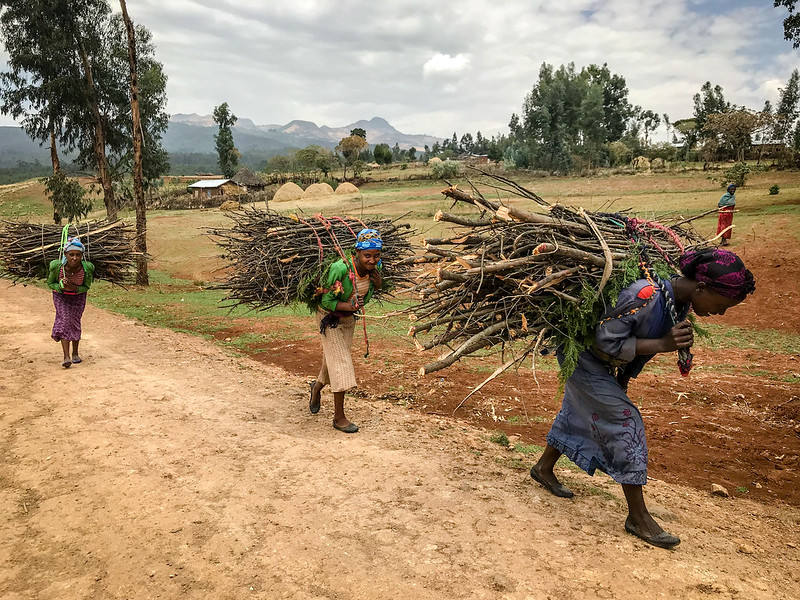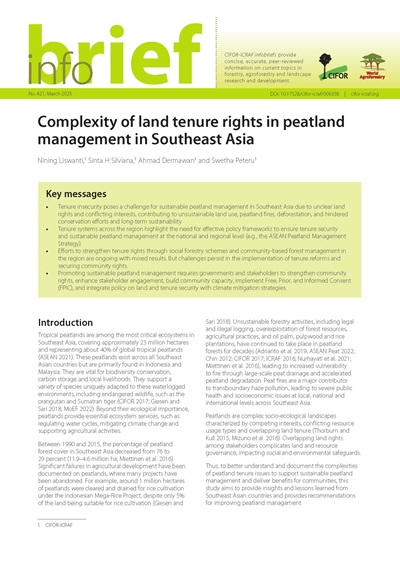Key messages
- Tenure insecurity poses a challenge for sustainable peatland management in Southeast Asia due to unclear land rights and conflicting interests, contributing to unsustainable land use, peatland fires, deforestation, and hindered conservation efforts and long-term sustainability.
- Tenure systems across the region highlight the need for effective policy frameworks to ensure tenure security and sustainable peatland management at the national and regional level (e.g., the ASEAN Peatland Management Strategy).
- Efforts to strengthen tenure rights through social forestry schemes and community-based forest management in the region are ongoing with mixed results. But challenges persist in the implementation of tenure reforms and securing community rights.
- Promoting sustainable peatland management requires governments and stakeholders to strengthen community rights, enhance stakeholder engagement, build community capacity, implement Free, Prior, and Informed Consent (FPIC), and integrate policy on land and tenure security with climate mitigation strategies.
DOI:
https://doi.org/10.17528/cifor-icraf/009358Dimensions Citation Count:
^ "Kangguru"
^ {#19649 +"id": "14c39a4d-a915-473e-9e9a-d8dd01ab96b4" +"origin_id": "9358" +"title": "Complexity of land tenure rights in peatland management in Southeast Asia" +"collection_group": array:1 [ 0 => "CIFOR" ] +"authors": array:4 [ 0 => "Liswanti, N." 1 => "Silviana, S.H." 2 => "Dermawan, A." 3 => "Peteru, S." ] +"description": "<p><b>Key messages</b></p><ul><li>Tenure insecurity poses a challenge for sustainable peatland management in Southeast Asia due to unclear land rights and conflicting interests, contributing to unsustainable land use, peatland fires, deforestation, and hindered conservation efforts and long-term sustainability.</li><li>Tenure systems across the region highlight the need for effective policy frameworks to ensure tenure security and sustainable peatland management at the national and regional level (e.g., the ASEAN Peatland Management Strategy).</li><li>Efforts to strengthen tenure rights through social forestry schemes and community-based forest management in the region are ongoing with mixed results. But challenges persist in the implementation of tenure reforms and securing community rights.</li><li>Promoting sustainable peatland management requires governments and stakeholders to strengthen community rights, enhance stakeholder engagement, build community capacity, implement Free, Prior, and Informed Consent (FPIC), and integrate policy on land and tenure security with climate mitigation strategies.</li></ul>" +"keywords": "" +"thumbnail": "https://www.cifor-icraf.org/uploads/webservice/9358.jpg" +"files": "https://www.cifor-icraf.org/publications/pdf_files/infobrief/9358-Infobrief.pdf" +"dc_source": "" +"published_date": "2025-03-10T00:00:00Z" +"topic": "" +"region": array:1 [ 0 => "Southeast Asia" ] +"country": "" +"country_links": "" +"pmo_code": "" +"language": "English" +"published_year": "" +"content_type": "Publication" +"project_funder_id": "" +"publisher": "" +"endnote": "" +"ris": "" +"keyword": array:7 [ 0 => "land tenure" 1 => "peatlands" 2 => "ecosystem management" 3 => "customary rights" 4 => "community involvement" 5 => "policy" 6 => "climate change mitigation" ] +"team": "" +"funded_by": "" +"data_relation": "" +"project_start_date": "" +"project_end_date": "" +"project_status": "" +"project_leader": "" +"project_leader_email": "" +"dcIdentifier": "https://doi.org/10.17528/cifor-icraf/009358" +"dcIdentifierUri": "https://data.cifor-icraf.org/dspace/handle/11463/43021" +"issn": "" +"isbn": "" +"cifor_uri": "" +"related": array:6 [ 0 => {#19653 +"id": "bfbf9e05-bf54-4e11-a722-31870458fe6e" +"item_id": array:1 [ 0 => "254877480970970964208284066662668420620" ] +"dcDateAccessioned": array:1 [ 0 => "2018-07-03T01:31:49Z" ] +"dcContributorAuthor": array:6 [ 0 => "Beckschfer, P." 1 => "Mundhenk, P." 2 => "Kleinn, C." 3 => "Ji, Y." 4 => "Yu, D.W." 5 => "Harrison, R.D." ] +"dcIdentifierUri": array:1 [ 0 => "#/11463/11682" ] +"dcType": array:1 [ 0 => "Journal Article" ] +"dctermsIssued": array:1 [ 0 => "2013-01-01T00:00:00Z" ] +"dcIdentifierIssn": array:1 [ 0 => "2163-0429" ] +"dcSubject": array:4 [ 0 => "forests" 1 => "poverty" 2 => "agroforestry" 3 => "germplasm" ] +"dcLanguageIso": array:1 [ 0 => "en" ] +"cgCoverageRegion": array:1 [ 0 => "East Asia" ] +"dcDocumentThumbnail": array:1 [ 0 => "https://www.cifor.org/uploads/webservice/21630429.jpg" ] +"cgContributorCrp": array:1 [ 0 => "CGIAR Research Program on Forests, Trees and Agroforestry (ForestsTreesAgroforestry)" ] +"dcDocumentUri": array:1 [ 0 => "http://www.scirp.org/journal/PaperDownload.aspx?paperID=26950" ] +"dcTitle": "Enhanced structural complexity index: an improved index for describing forest structural complexity" +"ciforSubjectFtapriority": array:1 [ 0 => "Landscape governance" ] +"dcIdentifierDoi": array:1 [ 0 => "https://doi.org/10.4236/ojf.2013.31005" ] +"cgCoverageCountry": array:1 [ 0 => "China" ] +"dcLanguage": array:1 [ 0 => "English" ] +"dcDateAvailable": array:1 [ 0 => "2018-07-03T01:31:49Z" ] +"ciforSubjectFtaflagship": array:2 [ 0 => "Flagship 3: Landscape management for Ecosystem services, biodiversity conservation and livelihoods" 1 => "Flagship 4: Landscape dynamics, productivity and resilience" ] +"last_modified": array:1 [ 0 => "2024-12-05T07:16:28Z" ] +"detail_id": array:1 [ 0 => "11709" ] +"dcDate": array:1 [ 0 => "2013-01-01T00:00:00Z" ] +"collectionGroup": array:1 [ 0 => "ICRAF" ] +"dcDateIssued": array:1 [ 0 => "2013-01-01T00:00:00Z" ] +"contentType": array:1 [ 0 => "Publication" ] +"score": 0.038004834 } 1 => {#19654 +"id": "4f5dd9f4-814b-471b-ad3a-ed5ddb9660b3" +"item_id": array:1 [ 0 => "105496315929422368688242680286644040024" ] +"cgContributorCrp": array:1 [ 0 => "CGIAR Research Program on Grain Legumes and Dryland Cereals (GLDC)" ] +"dcDocumentThumbnail": array:1 [ 0 => "https://www.cifor-icraf.org/uploads/webservice/0308521X.jpg" ] +"dcDocumentUri": array:1 [ 0 => "https://www.sciencedirect.com/science/article/pii/S0308521X24002300/pdf" ] +"dcIdentifierDoi": array:1 [ 0 => "https://doi.org/10.1016/j.agsy.2024.104080" ] +"dcIdentifierIssn": array:1 [ 0 => "0308-521X" ] +"dcLanguageIso": array:1 [ 0 => "en" ] +"dcDescriptionAbstract": array:1 [ 0 => "Complexity has long been recognised as a key feature of agri-food systems. Yet, it remains largely theoretical or poorly addressed in practice, hampering the potential of international development projects to address agriculture and food-related challenges in the Global South. The paper identifies and examines six sources of complexity that can manifest in projects, namely: unpredictability; path dependencies; context-specific dynamics; power relations; multiple temporal and spatial scales. It then proposes and tests six agri-food system principles that could be drawn upon to more successfully navigate this complexity. The aim of the paper is to illustrate how these principles could help projects respond to the changing circumstances and unpredictable turns of agri-food systems contexts in a different way, which flexibly embraces complexity. This flexibility is essential in an age of uncertainty and transformation. Comparative case study analysis of six projects implemented by the CGIAR: aflatoxin control in groundnuts in Malawi (1), pigeonpea in Eastern and Southern Africa (2), sorghum beer in Kenya (3), sweet sorghum for biofuel in India (4), precooked beans in Uganda and Kenya (5), Smart Foods in India and Eastern Africa (6). The projects aimed to either increasing smallholder farmers' incomes or addressing food and nutrition security, or both. They were specifically selected as all they were affected by some of the sources of complexity, which hampered the projects to different extents. This makes the cases relevant for not only illustrating manifestations of complexity, but also help reflect on alternative strategies to tackle it. The analysis of the case studies reveals how complexity can frustrate objectives of development interventions under several aspects. It also serves to discuss how complexity can be more successfully navigated (within but also beyond the selected cases) by applying the set of proposed agri-food system principles. The principles are also presented as ways future interventions could avoid clinging to what is “known to work” and instead venture into more powerful pathways of change." ] +"dcDateAccessioned": array:1 [ 0 => "2024-12-23T08:29:46Z" ] +"dcDateAvailable": array:1 [ 0 => "2024-12-23T08:29:46Z" ] +"dcContributorAuthor": array:5 [ 0 => "Conti, C." 1 => "Hall, A." 2 => "Orr, A." 3 => "Hambloch, C." 4 => "Mausch, K." ] +"dcSubject": array:5 [ 0 => "agriculture" 1 => "food systems" 2 => "development study" 3 => "comparative study" 4 => "case study" ] +"dcIdentifierUri": array:1 [ 0 => "https://data.cifor-icraf.org/dspace/handle/11463/39505" ] +"dcLanguage": array:1 [ 0 => "English" ] +"dcTitle": "Complexity-aware principles for agri-food system interventions: Lessons from project encounters with complexity" +"dcType": array:1 [ 0 => "Journal Article" ] +"dctermsIssued": array:1 [ 0 => "2024-01-01T00:00:00Z" ] +"last_modified": array:1 [ 0 => "2025-04-28T08:14:20Z" ] +"detail_id": array:1 [ 0 => "39505" ] +"dcDate": array:1 [ 0 => "2024-10-15T00:00:00Z" ] +"collectionGroup": array:1 [ 0 => "ICRAF" ] +"dcDateIssued": array:1 [ 0 => "2024-10-15T00:00:00Z" ] +"contentType": array:1 [ 0 => "Publication" ] +"score": 0.035801243 } 2 => {#19655 +"id": "40f63ae4-8215-429d-96cc-53c978d6c4de" +"item_id": array:1 [ 0 => "86349091241471018460484446066602420220" ] +"cgContributorDonor": array:1 [ 0 => "Department for International Development (DFID)" ] +"cgContributorProject": array:1 [ 0 => "Integrated use of agroforestry models to support policy formation" ] +"cgSubjectCifor": array:1 [ 0 => "Forest Management" ] +"dcDateAccessioned": array:1 [ 0 => "2014-06-25T10:06:51Z" ] +"dcDateAvailable": array:1 [ 0 => "2003-08-26T00:00:00Z" ] +"dcDescriptionAbstract": array:1 [ 0 => "Idealisation is the process of finding simple representations of the real-world whilst conceptualising a model. There are three ways to limit complication in a model of a complex real-world: by focussing the scope of the modelling process onto a clearly defined issue; by idealising elements of the real-world during model ceptualisation; and by simplifying the implemented simulation program. Careful idealisation has the greatest potential for increasing model tractability whilst generating insights during the model design process. The Forest Land Oriented Resource Envisioning System (FLORES) project deals with social forest landscapes which are highly complex. Benefits of idealisation are demonstrated using six examples from this modelling work. These examples encompass issues dealing with land tenure, forest management, economic values, social diversity, communication and collaboration. Each example illustrates a different method to achieve an idealisation which yields insights relevant for policy players. A number of lessons about idealisation are also identified: (1) sometimes it is only possible to recognise what is key by omitting it; (2) an effective idealisation is not just achieved by leaving things out, or adding them back in; (3) it is important to challenge the use of different units where consistency is possible; (4) it is easier to keep a simple model simple; and (5) even the most useful idealisations may have a limited shelf-life." ] +"dcDocumentThumbnail": array:1 [ 0 => "https://www.cifor.org/uploads/webservice/ciforpublications.jpg" ] +"dcIdentifierUri": array:1 [ 0 => "#/11463/2291" ] +"dcLanguageIso": array:1 [ 0 => "en" ] +"dcLanguage": array:1 [ 0 => "English" ] +"dcSubject": array:4 [ 0 => "simulation models" 1 => "methodology" 2 => "research projects" 3 => "social scientists" ] +"dcTitle": "Unlocking complexity: the importance of idealisation in simulation modelling" +"dctermsIssued": array:1 [ 0 => "2003-01-01T00:00:00Z" ] +"dcType": array:1 [ 0 => "Journal Article" ] +"dcContributorAuthor": array:2 [ 0 => "Haggith, M." 1 => "Prabhu, R." ] +"last_modified": array:1 [ 0 => "2025-02-06T08:51:47Z" ] +"detail_id": array:1 [ 0 => "1266" ] +"dcDate": array:1 [ 0 => "2003-06-25T00:00:00Z" ] +"collectionGroup": array:1 [ 0 => "CIFOR" ] +"dcDateIssued": array:1 [ 0 => "2003-06-25T00:00:00Z" ] +"contentType": array:1 [ 0 => "Publication" ] +"score": 0.02999789 } 3 => {#19656 +"id": "747b3828-8268-4f00-ba66-934b01aacafb" +"item_id": array:1 [ 0 => "154830239049073408042086822040222668824" ] +"dcDateAvailable": array:1 [ 0 => "2018-07-03T01:30:04Z" ] +"dctermsIssued": array:1 [ 0 => "2014-01-01T00:00:00Z" ] +"dcIdentifierUri": array:1 [ 0 => "#/11463/11340" ] +"dcType": array:1 [ 0 => "Journal Article" ] +"dcTitle": "Governing complexity for reducing emissions from deforestation and forest degradation (REDD)" +"ciforSubjectFtapriority": array:1 [ 0 => "Nationally determined contributions" ] +"dcIdentifierDoi": array:1 [ 0 => "https://doi.org/10.1080/14693062.2014.966645" ] +"dcLanguageIso": array:1 [ 0 => "en" ] +"dcIdentifierIssn": array:1 [ 0 => "1469-3062" ] +"dcSubject": array:3 [ 0 => "climate change" 1 => "governance" 2 => "forest management" ] +"dcContributorAuthor": array:1 [ 0 => "Vatn, A." ] +"cgContributorCrp": array:1 [ 0 => "CGIAR Research Program on Forests, Trees and Agroforestry (ForestsTreesAgroforestry)" ] +"dcDocumentThumbnail": array:1 [ 0 => "https://www.cifor.org/uploads/webservice/14693062.jpg" ] +"dcDescriptionAbstract": array:1 [ 0 => "The book can be seen as divided into three parts, discussing respectively the development of forests and forest governance, empirical case studies on REDD, and the future prospects for REDD. Three chapters are devoted to forests and forest governance, covering topics such as forest transition, deforestation and its drivers, forest policies and related organizations and institutions, and the emergence of REDD given these contexts. Four country-level case studies on Vietnam, Indonesia, Cameroon, and Peru and a comparative analysis of these country analyses are included. Finally, there are two summarizing chapters – one analysing the potential impacts of REDD on the global scale regarding deforestation, economic effects, and leakage, and the other linking back to the initial chapters, discussing the consequences for forest governance, including the prospects of REDD succeeding. As the book has a broad orientation it can be used for an in-depth evaluation of the challenges REDD implies for forest policy and the policies of other relevant sectors at various levels – from local to global. It can also be used as a book of reference regarding forest institutions, organizations, and policies." ] +"ciforSubjectFtaflagship": array:2 [ 0 => "Flagship 4: Climate change adaptation and mitigation" 1 => "Flagship 5: Climate change mitigation and adaptation" ] +"cgContributorDonor": array:1 [ 0 => "CGIAR" ] +"dcDateAccessioned": array:1 [ 0 => "2018-07-03T01:30:04Z" ] +"dcLanguage": array:1 [ 0 => "English" ] +"last_modified": array:1 [ 0 => "2024-12-07T14:51:37Z" ] +"detail_id": array:1 [ 0 => "11367" ] +"dcDate": array:1 [ 0 => "2014-01-01T00:00:00Z" ] +"collectionGroup": array:1 [ 0 => "ICRAF" ] +"dcDateIssued": array:1 [ 0 => "2014-01-01T00:00:00Z" ] +"contentType": array:1 [ 0 => "Publication" ] +"score": 0.027341254 } 4 => {#19703 +"id": "ce335a02-0499-4fa2-9338-b248125d1e85" +"item_id": array:1 [ 0 => "274087599848221988800806260046006808886" ] +"cgSubjectCifor": array:1 [ 0 => "Forest Management" ] +"ciforSourcePage": array:1 [ 0 => "20-47 [on line] URL: http://www.idrc.ca/en/ev-34000-201-1-DO_TOPIC.html" ] +"dcContributorAuthor": array:2 [ 0 => "McDougall, C." 1 => "Braun, A." ] +"dcDateAccessioned": array:1 [ 0 => "2014-11-24T15:25:52Z" ] +"dcDateAvailable": array:1 [ 0 => "2003-11-07T00:00:00Z" ] +"dcDescriptionAbstract": array:1 [ 0 => "This chapter seeks to address the apparent tensions that have arisen between ‘traditional' and ‘participatory' research approaches in natural resource management research. It does so not only by exploring the relative strengths and weaknesses of these approaches, but also by underscoring the complexity and dynamism inherent in human and natural systems that NRM research addresses. The chapter argues that the desired improvements in natural resource management demand that research institutions asses, more explicitly and thoughtfully than ever before, the multiple facets of traditional and participatory research approaches and consciously craft appropriate and innovative combinations of approaches for each research initiative." ] +"dcDocumentThumbnail": array:1 [ 0 => "https://www.cifor.org/uploads/webservice/books.jpg" ] +"dcIdentifierIsbn": array:1 [ 0 => "1-84407-026-3" ] +"dcIdentifierUri": array:1 [ 0 => "#/11463/2323" ] +"dcLanguageIso": array:1 [ 0 => "en" ] +"dcLanguage": array:1 [ 0 => "English" ] +"dcSubject": array:7 [ 0 => "participation" 1 => "resource management" 2 => "natural resources" 3 => "diversity" 4 => "integrated systems" 5 => "landscape" 6 => "research" ] +"dcTitle": "Navigating complexity, diversity and dynamism: reflections on research for natural resource management" +"dctermsIssued": array:1 [ 0 => "2003-01-01T00:00:00Z" ] +"dcType": array:1 [ 0 => "Chapter" ] +"last_modified": array:1 [ 0 => "2024-11-15T13:36:52Z" ] +"detail_id": array:1 [ 0 => "1300" ] +"dcDate": array:1 [ 0 => "2003-06-25T00:00:00Z" ] +"collectionGroup": array:1 [ 0 => "CIFOR" ] +"dcDateIssued": array:1 [ 0 => "2003-06-25T00:00:00Z" ] +"contentType": array:1 [ 0 => "Publication" ] +"score": 0.026181908 } 5 => {#18961 +"id": "a84d57c4-6bb9-405b-a0eb-aba8a1a41b8e" +"item_id": array:1 [ 0 => "223711890281667168408264482266002262624" ] +"dcDescriptionAbstract": array:1 [ 0 => "Integrated landscape approaches (ILA) aim to reconcile multiple, often competing, interests across agriculture, nature conservation, and other land uses. Recognized ILA design principles provide guidance for implementation, yet application remains challenging, and a strong performance evidence-base is yet to be formed. Through a critical literature review and focus group discussions with practitioners, we identified considerable diversity of ILA in actors, temporal, and spatial scales, inter alia. This diversity hampers learning from and steering ILA because of the intractable nature of the concept. Therefore, we developed a tool—an ‘ILA mixing board’—to structure the complexity of ILA into selectable and scalable attributes in a replicable way to allow planning, diagnosing, and comparing ILA. The ILA mixing board tool presents seven qualifiers, each representing a key attribute of ILA design and performance (for example, project flexibility, inclusiveness of the dialogue, and the centrality of the power distribution). Each qualifier has five (non-normative) outcome indicators that can be registered as present or absent. This process in turn guides planners, evaluators and other participating stakeholders involved in landscape management to diagnose the ILA type, or its performance. We apply the ILA mixing board to three ILA cases in Nicaragua, Madagascar, and the Congo Basin to show some of the many possible configurations of qualifiers on the mixing board. Further application of the tool would allow comparative analysis of the complexity of ILA in a structured and manageable way thereby enhancing the understanding of ILA performance and informing the development of evidence-based land use policy." ] +"dcIdentifierUri": array:1 [ 0 => "#/11463/34808" ] +"dctermsIssued": array:1 [ 0 => "2023-01-01T00:00:00Z" ] +"dcType": array:1 [ 0 => "Journal Article" ] +"dcDocumentThumbnail": array:1 [ 0 => "https://www.cifor.org/uploads/webservice/14629011.jpg" ] +"dcDocumentUri": array:1 [ 0 => "https://www.cifor-icraf.org/publications/pdf_files/articles/AReed2303.pdf" ] +"cgContributorCrp": array:1 [ 0 => "CGIAR Research Program on Water, Land and Ecosystems (WLE)" ] +"dcIdentifierIssn": array:1 [ 0 => "1873-6416" ] +"dcSubject": array:5 [ 0 => "governance" 1 => "natural resource management" 2 => "conservation" 3 => "ecosystem management" 4 => "conflict" ] +"dcContributorAuthor": array:11 [ 0 => "Waeber, P.O." 1 => "Carmenta, R." 2 => "Carmona, N.E." 3 => "Garcia, C.A." 4 => "Falk, T." 5 => "Fellay, A." 6 => "Ghazoul, J." 7 => "Reed, J." 8 => "Willemen, L." 9 => "Zhang, W." 10 => "Kleinschroth, F." ] +"dcLanguageIso": array:1 [ 0 => "en" ] +"dcIdentifierDoi": array:1 [ 0 => "https://doi.org/10.1016/j.envsci.2023.06.003" ] +"dcTitle": "Structuring the complexity of integrated landscape approaches into selectable, scalable, and measurable attributes" +"ciforDocumentUri": array:1 [ 0 => "English;/publications/pdf_files/articles/AReed2303.pdf;0;1.3 MB;Full" ] +"dcDateAvailable": array:1 [ 0 => "2023-07-21T10:50:27Z" ] +"dcLanguage": array:1 [ 0 => "English" ] +"cgSubjectCifor": array:1 [ 0 => "Landscape Approach" ] +"dcDateAccessioned": array:1 [ 0 => "2023-07-21T10:50:27Z" ] +"last_modified": array:1 [ 0 => "2025-01-16T07:27:52Z" ] +"detail_id": array:1 [ 0 => "8948" ] +"dcDate": array:1 [ 0 => "2023-06-10T00:00:00Z" ] +"collectionGroup": array:1 [ 0 => "CIFOR" ] +"dcDateIssued": array:1 [ 0 => "2023-06-10T00:00:00Z" ] +"ciforSubjectDomain": array:1 [ 0 => "Governance Equity and Wellbeing (GEW)" ] +"contentType": array:1 [ 0 => "Publication" ] +"score": 0.025116881 } ] }
Publication year
2025
Authors
Liswanti, N.; Silviana, S.H.; Dermawan, A.; Peteru, S.
Language
English
Keywords
land tenure, peatlands, ecosystem management, customary rights, community involvement, policy, climate change mitigation























